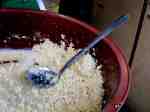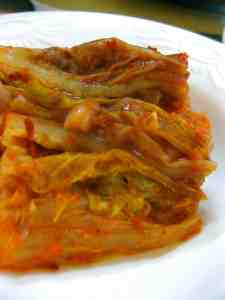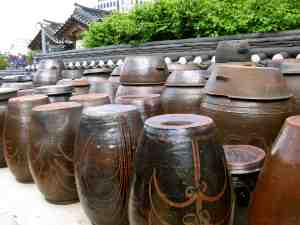It all started with a craving. Living in Germany for once in my life I was not without easily accessible quantities of kimchi. This in and of itself was a serious hardship, but more alarming was that without kimchi, I couldn’t make – kimchi chigae. Comfort food is a strange thing. To some it’s mac & cheese or mashed potatoes. The taste of home comes in a variety of packages. For my German roommate it was spaghetti with butter and ketchup. Comfort for me came wrapped up in the biggest clash of culinary sensibilities: a steaming, deliciously pungent bowl of kimchi chigae and a Big Mac.
Food associations are strong and unshakable, as the brilliant marketers for good old McDonalds can attest. As any one of my friends back in L.A. would confirm, I am not someone who has willingly eaten from the golden arches in years. My organic, home-made, farmer’s market loving nature had some serious issues with the kind of processed garbage that Ronald McDonald thankfully was no longer super sizing, but thousands of miles from “home,” lost in a bewildering foreign land without strong social networks or close friends and having seriously OD’d on the notion of Abendbrot (I could not eat any more slices of schwarzbrot, cheese & wurst with the prerequisite cut up cucumber!), Ronald became a reminder of pleasant childhood memories. Happy meals eaten during school field trips, deep fried apple pies and caramel sundaes, packages of the Hamburglar cookies…remember those? Big Macs were a special treat not often allowed by my notoriously health conscious mother and they are still imbedded in some far recess of my brain to trigger inexplicable feelings of warmth and security desperately needed that first long winter spent alone in Deutschland.
It’s the same way I feel about kimchi chigae. Call it my identity split. My American side sometimes just needs a dose of that “special sauce” in the same way the Korean gal in me needs her kimchi chigae. But although those cravings for Big Macs eventually dissipated as I acclimated to my new life situation, the desire for kimchi chigae refused to die. It was always my favorite meal growing up. So odoriferous my mother cooked it in the garage, the pungent fumes drifting out towards the sidewalk would make my American friends curl their noses in dismay…was that a dead animal in our garage? I’d pretend I didn’t hear them and for once be back home right on time for dinner.
So, what was a girl to do? The question of a Big Mac was easily solved. Globalization makes it possible to find a McDonalds anytime you’re jonesing for the crap they offer, (I will concede that sometimes a fresh batch of their fries with ketchup is just…dare I say, deelish?) The kimchi chigae though, now that posed a big problem. The few Korean establishments I’d found in Berlin rarely offered it, and when they did, it was a watered down, tasteless version lacking any of the penetrating zing of a proper chigae. This was seriously unacceptable. There was only one thing to do…make my own.
Since the only way to make a proper kimchi chigae is to first have suitably fermented kimchi, it meant that I needed to start from the very beginning, a very good place to start. This fräulein needed to make herself some kimchi! Now that was something I’d never needed to make before. Why bother when a huge bottle could be had 24-7 at several large Korean markets in L.A. or a homemade version could be pinched off of my aunt or mother. Once I had an available amount, I’d just whip myself a batch of chigae once the cabbage had gotten a little too salacious for normal ingestion. The precise timing in which to make the perfect chigae from fermented kimchi could be an art in and of itself. A fresh batch of kimchi just doesn’t have the right toe curling power, but wait until it’s gone too far and even a blowhard has a hard time digesting the sour, spicy mass. It’s reached proper maturation when you open a jar and the ensuing odor makes your eyes smart just a tiny leeetle bit and you’re not sure if it’s the kimchi or if you just passed gas.
Missing Korean food was not something I had accounted for when moving to Berlin. Sure it was something I ate back in L.A., but to be honest, I took it for granted. I could eat it whenever I wanted, so why bother eating it all the time? Those first endlessly grey months in Germany, I would rue the day I ever casually drove past a BCD Tofu House. My yearly visits back home now are filled with days of Korean bbq; accelerating inhalations of suhlung tang, daenjang chigae, kimbap, yookgejang, soon dubu, tansooyeuk, until my pants get uncomfortably snug and I consider slowing down consumption, only to think about the months and months of deprivation ahead and say- fuck it! and undo the button imprinting itself onto my increasing belly. Ahhh mah-shee-da!
So there was only one thing to do. I gave my mother a heart attack by asking her to teach me how to make kimchi my first visit back to the States. “Have you met a good Korean man?” were the first words out of her mouth. Apparently, the only thing that could possibly motivate me to want to make kimchi was in preparation of being a good Korean wife…*eye roll*… I had to set the record straight. (do you KNOW what its like dating in Germany where the notion of flirting is asking you how you made the gravy after waiting 3 months before even thinking about asking you on a date?!?! ) She tried to hide her disappointment, but chirked up with the idea that by teaching me kimchi, perhaps…perhaps…it would improve my chances of finding the perfect Korean doctor, lawyer or supremely successful business man, or if need be and under extreme duress (since I wasn’t getting any younger ; )) settling for the notion of a non-Korean, albeit only a non-Korean doctor, lawyer, or even more supremely successful business man, and as long as they were only white non-Korean men, preferably American because Europeans always have mistresses according to her friend who lived in Paris….Chinese was acceptable too, but under no circumstances Japanese!
Since getting into my color blind international dating choices would have given her a serious ulcer if not a real heart attack, we just moved onto the kimchi tutorial. Now there are as many varieties of kimchi as there are types of bread in Germany, whether you crave mouth burning fierceness or just a touch of the piquant, to cool summertime refreshing. Everyone will probably tell you their mother’s version is the best, and who am I to argue…it probably is. Something that gets served with pretty much every meal, every Korean child has eaten kimchi from the moment they can handle solid food. My mother would wash a piece off in a glass of water and cut it up into our rice porridge. I think by the time I was 5 I stopped “washing” my kimchi and just ate it straight up from the jar. The mouth of fire has had a long time to germinate!
This is my version of a basic nappa cabbage kimchi, tweaked after years of living in Berlin and also dealing with busy people and busy schedules that may not have the energy or time to do something 100% “traditional.” I think cooking is a fluid representation of where and when you live and being in Germany has obviously presented some obstacles. Ingredients are not always easily come by and sometimes impossible to find, so Fräulein Kimchi’s approach is to find what works in the environment you’re living in. There are no rules!
Fräulein Kimchi’s Kimchi recipe, to be used liberally as you please.
1 Nappa Cabbage (Chinakohl),
cut into small pieces (I usually cut it into about 2”x 2” slices, but whatever size you want is fine)
2 carrots julienned
2 bunches of green onions, cut into about 2” strips
1 or 2 apples, peeled and thinly sliced (*optional- I like to add apples which adds a nice crisp contrast to the cabbage, but this is not a really “traditional” ingredient so be prepared to face the ire of some die hard Koreans who may eat your kimchi. Just send them to Fräulein Kimchi if they give you any cheek)
1/2 daikon radish, peeled and sliced into thin rounds and then quartered (I prefer to use the Korean radish, which is called “mu”and has a spicier taste than daikon, but it’s not available in Germany…yet)
Garlic, 6-7 cloves, peeled and crushed
Ginger, 1 tablespoon finely minced
Sea salt, 2-5 tablespoons per cabbage (my aunt swears that the type of salt you use influences the taste of the kimchi. Don’t use the super high end gourmet sea salt though since you will need a lot of salt. Large bags of sea salt can usually be found fairly cheaply at most asian markets)
Korean chili powder “Kochugaru” (while it’s best to use Korean chili powder, if it’s not available in your area, you “can” use a different kind of chili powder.
Be sure to experiment with amounts though, as Korean chili powder has a more mellow heat to it that necessitates using quite a bit when making kimchi. Other chili powders may pack more heat so take caution! Also, its best if you use Korean chili powder that has been produced in Korea and not China. Look for a package that has a bright red color to it, which signifies freshness. If it’s made in China and is neon bright though, it’s probably been dyed synthetically! Avoid! To maintain freshness of the chili powder, keep it in your freezer).
Fish sauce, about 2-3 tablespoons (For the best flavor I suggest you don’t buy the Thai anchovy fish sauces, but a Korean version. It’s called Sand Lance Sauce. This is also something you should add to your taste. More fish sauce will give it a stronger flavor so see what you prefer. To be super hardcore traditional, use the tiny salted shrimps that come in a jar. So far its been impossible for me to find in Germany, but easily found in Korean supermarkets in America)
Pair of plastic gloves
directions: In a large bowl heavily salt the cabbage pieces. For a large cabbage it will take about 4-5 tablespoons, for a smaller one 3-4. Let it sit for a minimum of an hour and up to anywhere from 2-3 hours. The longer it stays in the salt, the more the cabbage breaks down and releases its water. It also absorbs more salt and gets saltier, so experiment and see which texture and seasoning you prefer. If you use a whole cabbage without cutting it up then it needs to salt overnight. (This is the traditional way of making kimchi, but also requires much larger jars which aren’t easily come by in Berlin. Its also more of a mess to cut up and serve once its fermented)
Wash off the salt from the cabbage and squeeze it dry. Taste a piece; it should be slightly salty. Place the cabbage in a large bowl and add the garlic, ginger, carrots, apples and radish. Add the kochugaru a bit at a time. This is to your taste, the more kochugaru you use, the spicier it will be. Add the fish sauce and green onions and mix thoroughly with your hands (make sure to wear the plastic gloves if you don’t want your hands reeking of garlic and fish for days!) The final mixture shouldn’t be too dry, the chili powder should start to expand slightly from the moisture. If it seems too dry once you’ve added all the ingredients, then you can add a tiny bit of water to loosen it up.
Gather some clean empty jars and start to bottle. As you spoon in the fresh kimchi make sure you press it down firmly into the bottom of the jar. There should be no space or air between the layers and a little bit of liquid at the top of the jar just covering the cabbage. Leave some space on top as the kimchi will expand and create more liquid as it starts to ferment (packing the kimchi too tightly to the top of the lid can create a juicy, smelly explosion when you first try to open it).
Leave a jar out on the counter so that you can eat it within a day or two. The rest of the jars will last for weeks if not months if properly stored in the fridge. After a few weeks have gone by and the kimchi has gone sour…it’s time to make some chigae!
Some pictures of the finished product as I found them in Korea…enjoy!

the richer you were, the larger the urns..these humongoids were found next to the house of a rich yangban











2 Comments
Comments are closed.